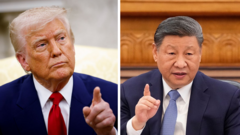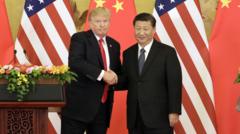In-depth analysis of the recent US-China deal addressing import tariffs and its potential implications.
**US-China Tariff Agreement: A Significant Trade Truce Explained**

**US-China Tariff Agreement: A Significant Trade Truce Explained**
Both nations agree to cut tariffs, easing tensions in the ongoing trade dispute.
The United States and China have reached a crucial agreement aimed at reducing import tariffs on goods exchanged between the two economic giants, marking a significant de-escalation of their ongoing trade conflict. The truce comes amid a climate of heightened tensions that have shaken other economies globally, with the UK among those feeling the repercussions.
The newly established agreement entails both nations easing some of the tariffs implemented recently due to the trade spat initiated by former President Donald Trump. Specifically, the deal will see US tariffs on Chinese imports decreased from 145% to 30%, while China will cut tariffs on select US goods from 125% to 10%. Furthermore, China is set to retract non-tariff measures, such as the previous ban on crucial mineral exports to the US. However, a 20% tariff component will remain in place, aimed at compelling China to take stricter action against the illicit fentanyl trade.
The announcement follows a high-level discussion held in Switzerland, which marked the first formal talks between the two nations since the escalation of tariffs began earlier in the year. Looking beyond the initial 90-day suspension of tariffs, speculations abound regarding the trajectory of US-China relations; while there remains a real possibility of a return to previous tariff structures, consensus between the two leaders reflects a mutual desire to prevent economic decoupling.
Trade statistics reveal a complex exchange between the nations. In 2024, the predominant US exports to China included soybeans, pharmaceuticals, and petroleum products. In contrast, China’s exports to the US are largely electronic devices, with smartphones alone piercing 9% of total US imports from China. The trade balance heavily favors China, with the US importing approximately $440 billion worth of goods while exporting only $145 billion in return, a disparity President Trump sought to address through his tariff policies.
Despite each side’s claims of victory, interpretations of the agreement may vary. Analysts caution that while Beijing may view the concessions as a victory for their diplomacy, the US administration is likely to interpret the reduction as a strategic win showcasing its negotiation prowess. Economists believe the lowered tariffs mark a defining moment in shaping future trade policies, suggesting a possible range within which American tariffs could stabilize moving forward.
With investor sentiment increasingly optimistic following the truce, there is anticipation of a resurgence in trans-Pacific shipping activities. Yet the ongoing negotiations suggest the path forward remains fraught with uncertainty. As both nations embark on these delicate discussions, the question of who truly benefits from this agreement continues to loom large, leaving businesses and economists cautiously optimistic about future trade dynamics.
The newly established agreement entails both nations easing some of the tariffs implemented recently due to the trade spat initiated by former President Donald Trump. Specifically, the deal will see US tariffs on Chinese imports decreased from 145% to 30%, while China will cut tariffs on select US goods from 125% to 10%. Furthermore, China is set to retract non-tariff measures, such as the previous ban on crucial mineral exports to the US. However, a 20% tariff component will remain in place, aimed at compelling China to take stricter action against the illicit fentanyl trade.
The announcement follows a high-level discussion held in Switzerland, which marked the first formal talks between the two nations since the escalation of tariffs began earlier in the year. Looking beyond the initial 90-day suspension of tariffs, speculations abound regarding the trajectory of US-China relations; while there remains a real possibility of a return to previous tariff structures, consensus between the two leaders reflects a mutual desire to prevent economic decoupling.
Trade statistics reveal a complex exchange between the nations. In 2024, the predominant US exports to China included soybeans, pharmaceuticals, and petroleum products. In contrast, China’s exports to the US are largely electronic devices, with smartphones alone piercing 9% of total US imports from China. The trade balance heavily favors China, with the US importing approximately $440 billion worth of goods while exporting only $145 billion in return, a disparity President Trump sought to address through his tariff policies.
Despite each side’s claims of victory, interpretations of the agreement may vary. Analysts caution that while Beijing may view the concessions as a victory for their diplomacy, the US administration is likely to interpret the reduction as a strategic win showcasing its negotiation prowess. Economists believe the lowered tariffs mark a defining moment in shaping future trade policies, suggesting a possible range within which American tariffs could stabilize moving forward.
With investor sentiment increasingly optimistic following the truce, there is anticipation of a resurgence in trans-Pacific shipping activities. Yet the ongoing negotiations suggest the path forward remains fraught with uncertainty. As both nations embark on these delicate discussions, the question of who truly benefits from this agreement continues to loom large, leaving businesses and economists cautiously optimistic about future trade dynamics.























